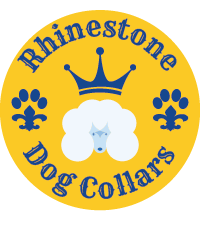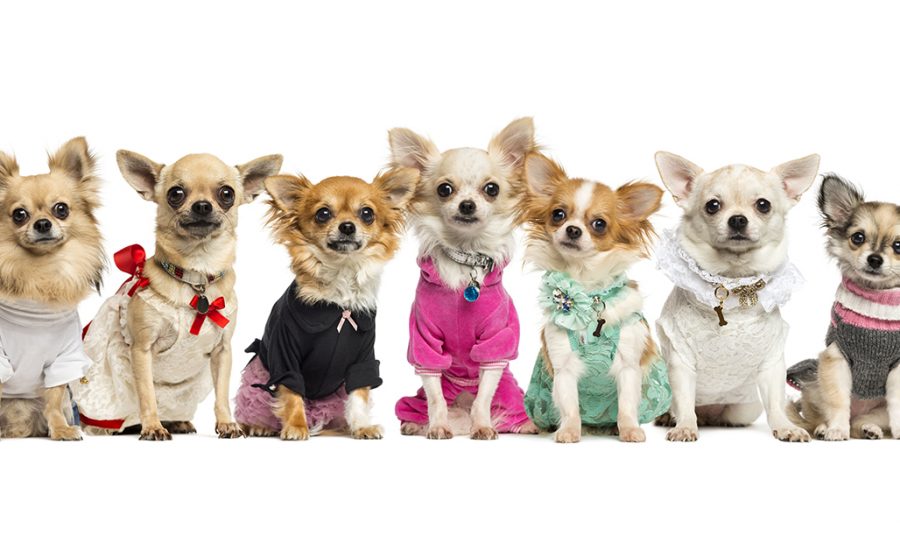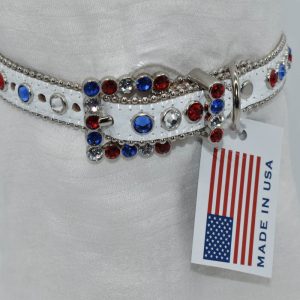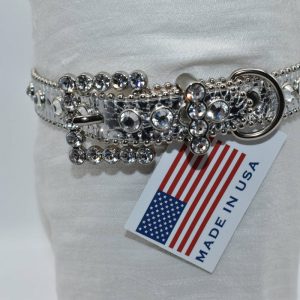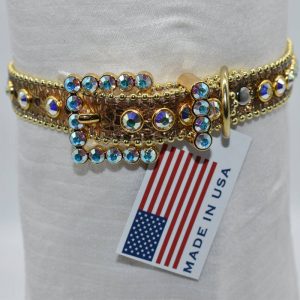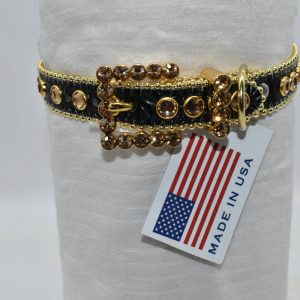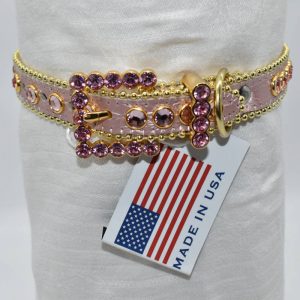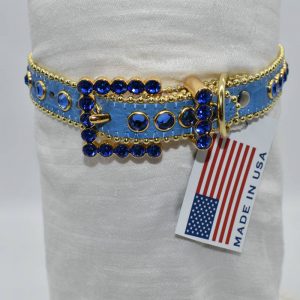Dog collars are more than just fashion accessories; they serve a crucial role in training, safety, and control of our beloved canine companions.
With the plethora of options available in the market, choosing the right collar can be overwhelming.
In this comprehensive guide, we will delve into various types of dog collars, including head collars, martingale collars, choke collars, prong collars, harnesses, e-collars, bark collars, dog harnesses, and flea collars.
We’ll define each type, explore their purposes, and discuss the pros and cons to help you make an informed decision for your furry friend.
We also recommend you view our Rhinestone Dog Collars for sale.
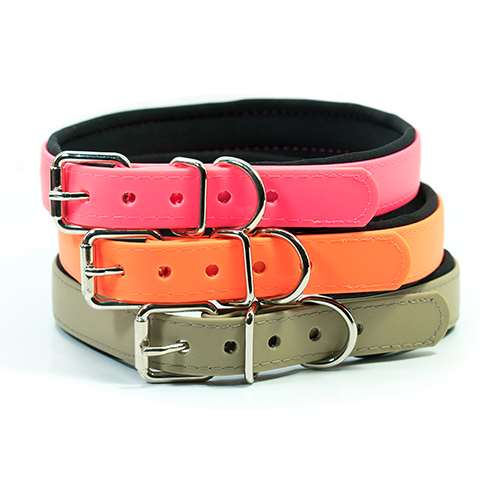
Types of Dog Collars
- Head collars
- Martingale collars
- Choke Prong collar
- Harnesses
- E collar
- Bark Collar
- Dog Harness
- Flea collars
Head Collars
Head collars, also known as head halters, are designed to fit around a dog’s muzzle and neck, providing control by steering the dog’s head. They work similarly to a horse’s halter and are often used for training and managing strong or reactive dogs. Head collars can help discourage pulling and redirect a dog’s attention.
Pros:
- Provides control over the dog’s head, steering them in the desired direction.
- Can be effective for training purposes, especially for dogs prone to pulling.
- Reduces the risk of neck injuries compared to traditional collars.
Cons:
- Some dogs may initially resist wearing a head collar.
- Improper fitting can cause discomfort or rubbing on the dog’s nose.
- Not suitable for brachycephalic breeds due to their short muzzles.
Martingale Collars
Martingale collars, also called limited-slip collars, consist of a loop that tightens when tension is applied but only to a certain extent, preventing choking. These collars are commonly used for dogs with narrow heads, such as Greyhounds and Whippets, to prevent them from slipping out of the collar.
Pros:
- Provides gentle control without choking the dog.
- Prevents escape in dogs with narrow heads or those prone to slipping out of traditional collars.
- Offers more control than regular flat collars.
Cons:
- Requires proper adjustment to ensure it tightens appropriately without causing discomfort.
- Not suitable for dogs who pull excessively or are prone to tracheal issues.
Choke Collars
Choke collars, also known as slip collars or check chains, are made of metal chain links that tighten around a dog’s neck when tension is applied. They are typically used for training purposes, primarily in obedience training.
Pros:
- Can provide quick correction for certain behavioral issues.
- Offers control over the dog’s movements.
- Relatively inexpensive compared to some other collar options.
Cons:
- Can cause injury if used improperly or with excessive force.
- May lead to tracheal damage, especially in dogs that pull forcefully.
- Not recommended for inexperienced dog owners or sensitive breeds.
Prong Collars
Prong collars, also called pinch collars, consist of metal links with blunt prongs that pinch the dog’s neck when tension is applied. They are designed to mimic the correction a dog would receive from a pack leader or mother dog.
Pros:
- Provides precise and effective correction for strong-willed or stubborn dogs.
- Can help deter pulling and improve walking behavior.
- Allows for quick release of pressure once the desired behavior is achieved.
Cons:
- Controversial and often criticized for being harsh or inhumane.
- Requires proper fitting and training to prevent injury or discomfort.
- Not suitable for all dogs, especially those with sensitive skin or neck issues.
Harnesses
Dog harnesses are designed to fit around a dog’s body, distributing pressure more evenly than collars. There are various types of harnesses, including back-clip, front-clip, and dual-clip options, each serving different purposes.
Pros:
- Reduces strain on the dog’s neck and throat, especially for breeds prone to respiratory issues.
- Offers better control over dogs that pull, jump, or have leash-reactive behavior.
- Can be used for various activities, including walking, hiking, and sports.
Cons:
- Some dogs may learn to pull more with a harness, especially with back-clip designs.
- Can be more challenging to put on and adjust than collars.
- Requires proper fitting to prevent chafing or rubbing.
E-Collars
E-collars, also known as electronic or shock collars, deliver a mild electric stimulation to the dog’s neck via a remote control. They are often used for remote training, behavior modification, or containment purposes.
Pros:
- Provides immediate correction from a distance, useful for off-leash training or controlling unwanted behaviors.
- Can be customized to deliver various levels of stimulation.
- Effective for addressing certain behavioral issues, such as excessive barking or aggression.
Cons:
- Controversial and may cause discomfort or stress to the dog if used improperly.
- Requires proper training and supervision to ensure humane use.
- Not suitable for all dogs, particularly those with anxiety or fear-related issues.
Bark Collars
Bark collars are designed to deter excessive barking by delivering a corrective stimulus, such as a spray, vibration, or mild shock, when the dog barks. They are available in various forms, including citronella collars, ultrasonic collars, and static correction collars.
Pros:
- Can help address nuisance barking without human intervention.
- Provides consistent correction, even when the owner is not present.
- May be effective for dogs with stubborn barking habits.
Cons:
- Some bark collars may be triggered by other sounds or vibrations, leading to unintentional correction.
- May not address the underlying cause of the barking behavior.
- Not recommended as a sole solution for barking issues, and should be used in conjunction with training and behavior modification techniques.
Dog Harness
A dog harness is a type of equipment used to secure and control dogs. Unlike collars, which typically loop around a dog’s neck, harnesses wrap around the dog’s body and distribute pressure more evenly.
Pros:
- Provides better control over the dog, especially for those prone to pulling or escaping.
- Reduces strain on the neck and throat, particularly for dogs with respiratory issues.
- Can be used for various activities, including walking, running, and hiking.
Cons:
- Some dogs may resist wearing a harness initially.
- Requires proper fitting to prevent chafing or discomfort.
- May not be as effective for training purposes as certain types of collars.
Flea Collars
Flea collars are designed to repel or kill fleas and ticks by releasing chemicals that are toxic to these pests. They are worn around the dog’s neck and provide continuous protection against infestations.
Pros:
- Offers long-lasting protection against fleas and ticks.
- Convenient and easy to use, requiring minimal maintenance.
- Can help prevent flea-related diseases and discomfort for the dog.
Cons:
- Some flea collars may contain harsh chemicals that could be harmful to the dog or humans.
- Effectiveness may vary depending on the collar’s ingredients and design.
- Not suitable for dogs with sensitive skin or allergies to certain chemicals.
Conclusion on Types of Dog Collars
Choosing the right collar for your dog is essential for their safety, comfort, and well-being. Each type of collar serves a different purpose and comes with its own set of pros and cons. By understanding the characteristics and uses of various collars, you can make an informed decision based on your dog’s needs and behaviors.
Our Favorite Type of Dog Collar
-
Product on sale
 BB Simon Swarovski Crystal Leather Rhinestone Dog Collar – DC AmericaOriginal price was: $89.00.$76.00Current price is: $76.00.
BB Simon Swarovski Crystal Leather Rhinestone Dog Collar – DC AmericaOriginal price was: $89.00.$76.00Current price is: $76.00. -
 BB Simon Swarovski Crystal Leather Rhinestone Dog Collar – DC Silver$89.00
BB Simon Swarovski Crystal Leather Rhinestone Dog Collar – DC Silver$89.00 -
 BB Simon Swarovski Crystal Leather Rhinestone Dog Collar – DC Gold$89.00
BB Simon Swarovski Crystal Leather Rhinestone Dog Collar – DC Gold$89.00 -
 BB Simon Swarovski Crystal Leather Rhinestone Dog Collars – DC Black$89.00
BB Simon Swarovski Crystal Leather Rhinestone Dog Collars – DC Black$89.00 -
 BB Simon Swarovski Crystal Leather Rhinestone Dog Collars – DC Pink$89.00
BB Simon Swarovski Crystal Leather Rhinestone Dog Collars – DC Pink$89.00 -
 BB Simon Swarovski Crystal Leather Rhinestone Dog Collar – DC Blue$89.00
BB Simon Swarovski Crystal Leather Rhinestone Dog Collar – DC Blue$89.00
